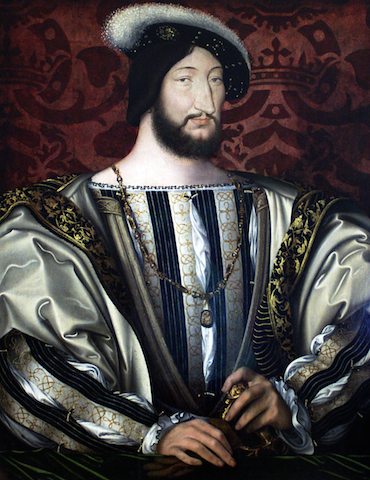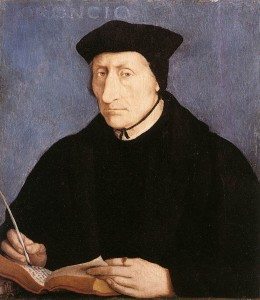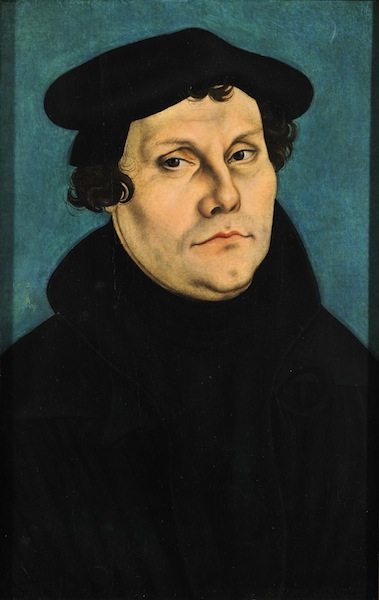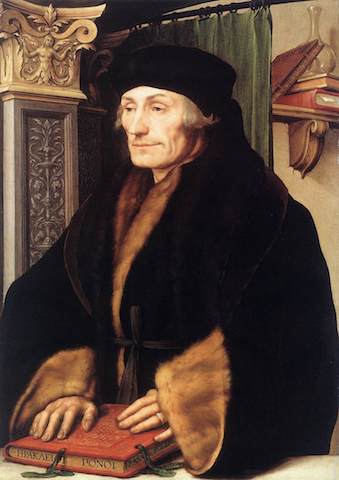Week 21
Week 21: Monday, March 31, 2025
Renaissance in France: Francis I & Guillaume Budé
Week 21
The two men pictured here are central to this week's study, since it is during the lifetime of King Francis I, that France engages fully with the ideas and artistic achievements of the Italian Renaissance. Budé was the intellectual teacher for the King on those educational ideas that mattered. His influence would help to change Medieval France into Renaissance France. One such idea was a college that would prepare young French students with a knowledge of Latin and Greek (Hebrew too) and the cultural heritage of Rome and Greece. In other words, Budé's idea about the College of France (which the King founded as recommended by Budé) was the very core of all modern ideas about an education in the humanities before graduate school (Medical, Legal, or Business). From 1500 to 2000 most colleges would have agreed and would have provided, until recently, exactly this humanistic education that Budé recommended.
RECOMMENDED READING:
J. R. Hale, The Civilization of Europe in the Renaissance. This study of the whole Renaissance period in all of Europe was the final masterpiece of one of the greatest historians of the Early Modern period. John Hale was working on this book when he suffered a debilitating stroke. But his wife, Sheila Hale, and other scholars finished the book for publication and we are all enriched by its availability. It is in print, but you might also look at used copies of the original quality paperback. This book will serve us for the whole year-long course. It is especially useful for Winter and Spring Quarters.

John Hale,
The Civilization of Europe in the Renaissance,
Scribner, Reprint edition (June 1, 1995),
ISBN 0684803526
22
Week 22: Monday, April 7, 2025
The Renaissance in France: Italian Artists in France
Week 22
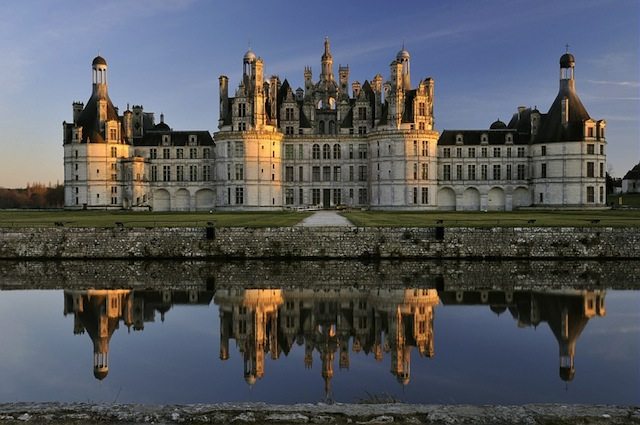
The chateau above is Chambord. It is the single best example of the power of Italian Renaissance art in France. It is very possibly the idea of Leonardo da Vinci who lived in Amboise as the guest of King Francis I in the last years of his life. That Leonardo would choose France for his last years, tells us of the attraction that the northern kingdom held for Italians. Leonardo was the most celebrated Italian painter of the time. His painting of the Last Supper in Milan, was now the most famous painting anywhere in Europe. Did he plan this fabulous chateau with Francis? If he did, and I think he did, then it remains to this day the best example of the enduring power of Renaissance classicism, the same architectural style that would soon be described in detail in the great book by Andrea Palladio published in Venice in 1570, the single most influential book on architecture ever published.
23
Week 23: Monday, April 14, 2025
The Renaissance in Spain: Ferdinand and Isabella
Week 23
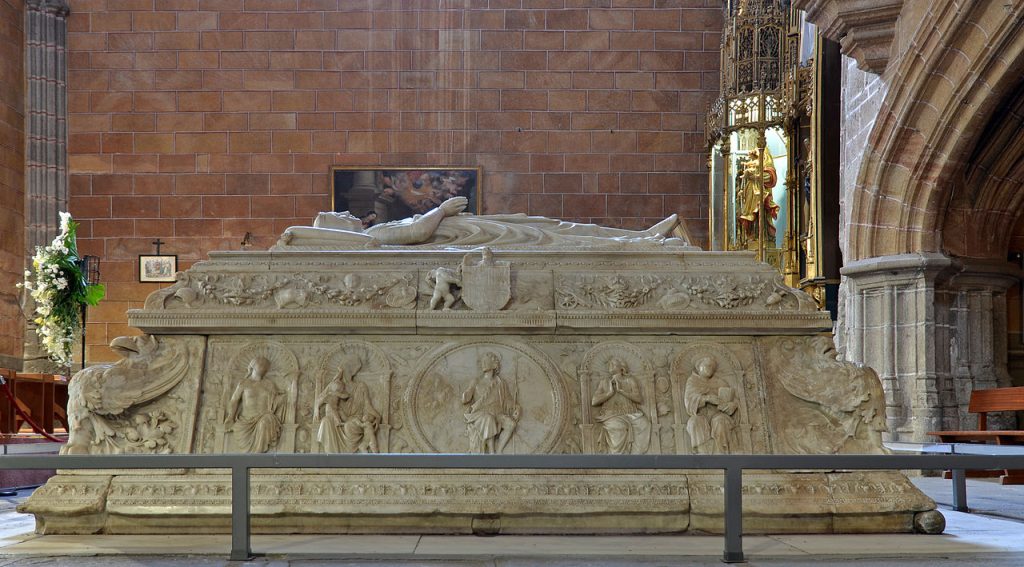 The photo above is of the tomb of Juan, Prince of Asturias, the beloved son of Ferdinand and Isabella. The prince, the future ruler of the united nation of Spain, had died in 1497. And here in this monastery, Domenico Fancelli from Florence, carved this magnificent tomb using all the knowledge and skill that had been accumulated in Renaissance Florence. Later he also created the great tombs for Ferdinand and Isabella in Granada.
The photo above is of the tomb of Juan, Prince of Asturias, the beloved son of Ferdinand and Isabella. The prince, the future ruler of the united nation of Spain, had died in 1497. And here in this monastery, Domenico Fancelli from Florence, carved this magnificent tomb using all the knowledge and skill that had been accumulated in Renaissance Florence. Later he also created the great tombs for Ferdinand and Isabella in Granada.
RECOMMENDED READING:
J. R. Hale, The Civilization of Europe in the Renaissance. This study of the whole Renaissance period in all of Europe was the final masterpiece of one of the greatest historians of the Early Modern period. John Hale was working on this book when he suffered a debilitating stroke. But his wife, Sheila Hale, and other scholars finished the book for publication and we are all enriched by its availability. It is in print, but you might also look at used copies of the original quality paperback. This book will serve us for the whole year-long course. It is especially useful for Winter and Spring Quarters.

John Hale,
The Civilization of Europe in the Renaissance,
Scribner, Reprint edition (June 1, 1995),
ISBN 0684803526
RECOMMENDED READING:
This is a beautiful book which covers the whole of the Renaissance in every field and every country. Margaret King is one of the greatest American scholars of the Renaissance, and she has written a very useful general book on the subject. What is especially attractive, is all the extra material: the charts, the maps, the photos, all of which make this a great study of the Renaissance. It would be a useful "textbook" for our whole year on the Renaissance. It was, of course, designed as a college textbook for a course on the Renaissance. If you buy a new copy, it is 35$ but there are many used copies listed on Amazon.
Margaret L. King, is Professor Emerita of history at Brooklyn College and the Graduate Center, City University of New York. She is the author of several books on women, humanism, and Venice in the Renaissance, and is currently editor-in-chief of the Renaissance and Reformation online bibliography published by Oxford Bibliographies.

Margaret L. King,
The Renaissance in Europe,
Laurence King Publishing; 2 edition (January 1, 2003),
ISBN 1856693740
24
Week 24: Monday, April 21, 2025
The Renaissance in Spain: Women
Week 24
In the Fifteenth and Sixteenth Century, the definition of a good life for a woman changed. The Renaissance produced a whole new idea about what was the right role for a woman. Spain produced one of the most remarkable women of the age: Queen Isabella of Castile. Isabella was an extraordinary woman ruler. She brought the warring factions of Castile together and with the help of her husband Ferdinand from Aragon, she united all of Spain. But her achievement was only more extraordinary when you realize that her daughters learned what their mother taught them and they too went on to important roles in various European courts.
RECOMMENDED READING:
J. R. Hale, The Civilization of Europe in the Renaissance. This study of the whole Renaissance period in all of Europe was the final masterpiece of one of the greatest historians of the Early Modern period. John Hale was working on this book when he suffered a debilitating stroke. But his wife, Sheila Hale, and other scholars finished the book for publication and we are all enriched by its availability. It is in print, but you might also look at used copies of the original quality paperback. This book will serve us for the whole year-long course. It is especially useful for Winter and Spring Quarters.

John Hale,
The Civilization of Europe in the Renaissance,
Scribner, Reprint edition (June 1, 1995),
ISBN 0684803526
RECOMMENDED READING:
This is a beautiful book which covers the whole of the Renaissance in every field and every country. Margaret King is one of the greatest American scholars of the Renaissance, and she has written a very useful general book on the subject. What is especially attractive, is all the extra material: the charts, the maps, the photos, all of which make this a great study of the Renaissance. It would be a useful "textbook" for our whole year on the Renaissance. It was, of course, designed as a college textbook for a course on the Renaissance. If you buy a new copy, it is 35$ but there are many used copies listed on Amazon.
Margaret L. King, is Professor Emerita of history at Brooklyn College and the Graduate Center, City University of New York. She is the author of several books on women, humanism, and Venice in the Renaissance, and is currently editor-in-chief of the Renaissance and Reformation online bibliography published by Oxford Bibliographies.

Margaret L. King,
The Renaissance in Europe,
Laurence King Publishing; 2 edition (January 1, 2003),
ISBN 1856693740
25
Week 25: Monday, April 28, 2025
Renaissance Man: Emperor Charles V
Week 25
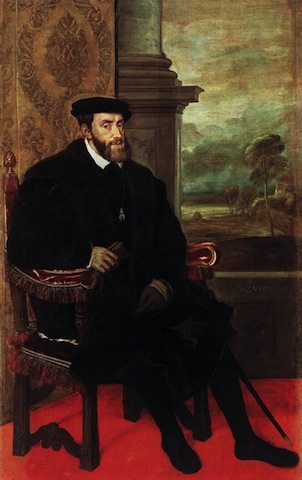
The portrait of Charles V that you see at the left was painted by Titian and is currently on view in the Prado in Madrid. Charles V (and also at the same time King Carlos I of Spain) was the single most important, the most powerful, the most dominant personality of the sixteenth century in Europe. Charles lived from 1500 to 1558 and thus he dominated the whole first half of the century and his influence continued through the rest of the century through the person of his son King Philip II who was his student in the intricacies of 16th century government and followed his policies loyally. Charles's biography is the story of someone who grew up in many states and using many languages, but who in the last years of his life became more and more Spanish. He became the most elegant, the most powerful and the best educated Renaissance Man of the century.
RECOMMENDED READING:

John Hale,
The Civilization of Europe in the Renaissance,
Scribner, Reprint edition (June 1, 1995),
ISBN 0684803526
RECOMMENDED READING:
This is a beautiful book which covers the whole of the Renaissance in every field and every country. Margaret King is one of the greatest American scholars of the Renaissance, and she has written a very useful general book on the subject. What is especially attractive, is all the extra material: the charts, the maps, the photos, all of which make this a great study of the Renaissance. It would be a useful "textbook" for our whole year on the Renaissance. It was, of course, designed as a college textbook for a course on the Renaissance. If you buy a new copy, it is 35$ but there are many used copies listed on Amazon.
Margaret L. King, is Professor Emerita of history at Brooklyn College and the Graduate Center, City University of New York. She is the author of several books on women, humanism, and Venice in the Renaissance, and is currently editor-in-chief of the Renaissance and Reformation online bibliography published by Oxford Bibliographies.

Margaret L. King,
The Renaissance in Europe,
Laurence King Publishing; 2 edition (January 1, 2003),
ISBN 1856693740
26
Week 26: Monday, May 5, 2025
The Renaissance in Germany: Martin Luther
Week 26
The portrait of Martin Luther on this page was painted by Lucas Cranach in 1528, when Luther was becoming the most famous writer in Europe. We now think of Luther as a Reformation leader. But Luther was a Renaissance scholar before he became a Reformation leader. Like all the men in the Reformation movement, Luther was a great Classical scholar who knew Latin and Greek. He was a scholar, a university professor, before he was anything else. And his career before 1517, shows us that the Reformation was nourished by Renaissance scholarship before the religious fireworks exploded. The Renaissance led to the Reformation.
RECOMMENDED READING:

John Hale,
The Civilization of Europe in the Renaissance,
Scribner, Reprint edition (June 1, 1995),
ISBN 0684803526
RECOMMENDED READING:
This is a beautiful book which covers the whole of the Renaissance in every field and every country. Margaret King is one of the greatest American scholars of the Renaissance, and she has written a very useful general book on the subject. What is especially attractive, is all the extra material: the charts, the maps, the photos, all of which make this a great study of the Renaissance. It would be a useful "textbook" for our whole year on the Renaissance. It was, of course, designed as a college textbook for a course on the Renaissance. If you buy a new copy, it is 35$ but there are many used copies listed on Amazon.
Margaret L. King, is Professor Emerita of history at Brooklyn College and the Graduate Center, City University of New York. She is the author of several books on women, humanism, and Venice in the Renaissance, and is currently editor-in-chief of the Renaissance and Reformation online bibliography published by Oxford Bibliographies.

Margaret L. King,
The Renaissance in Europe,
Laurence King Publishing; 2 edition (January 1, 2003),
ISBN 1856693740
27
Week 27: Monday, May 12, 2025
The Renaissance in the Netherlands: Erasmus
Week 27
Above you see the brilliant portrait of Erasmus by his friend Hans Holbein. Erasmus was famous much before Luther. And his achievement of publishing and New Testament in Latin and Greek provided Luther with much of the work for his own German Bible. Erasmus and Luther shared much in their mutual disdain for the corruption of the Roman church. But Erasmus stopped short of breaking completely with Rome. Thus, Luther and Erasmus show us two possible roads in the early 16th century: one led to total rebellion and the other one led to the reformed Roman church.
RECOMMENDED READING:

John Hale,
The Civilization of Europe in the Renaissance,
Scribner, Reprint edition (June 1, 1995),
ISBN 0684803526
RECOMMENDED READING:
This is a beautiful book which covers the whole of the Renaissance in every field and every country. Margaret King is one of the greatest American scholars of the Renaissance, and she has written a very useful general book on the subject. What is especially attractive, is all the extra material: the charts, the maps, the photos, all of which make this a great study of the Renaissance. It would be a useful "textbook" for our whole year on the Renaissance. It was, of course, designed as a college textbook for a course on the Renaissance. If you buy a new copy, it is 35$ but there are many used copies listed on Amazon.
Margaret L. King, is Professor Emerita of history at Brooklyn College and the Graduate Center, City University of New York. She is the author of several books on women, humanism, and Venice in the Renaissance, and is currently editor-in-chief of the Renaissance and Reformation online bibliography published by Oxford Bibliographies.

Margaret L. King,
The Renaissance in Europe,
Laurence King Publishing; 2 edition (January 1, 2003),
ISBN 1856693740

Desiderius Erasmus,
The Praise of Folly and Other Writings,
Robert M. Adams, editor,
W. W. Norton & Company; 1st ed edition (October 17, 1989),
ISBN 0393957497
28
Week 28: Monday, May 19, 2025
The Renaissance in England: Henry VIII
Week 29
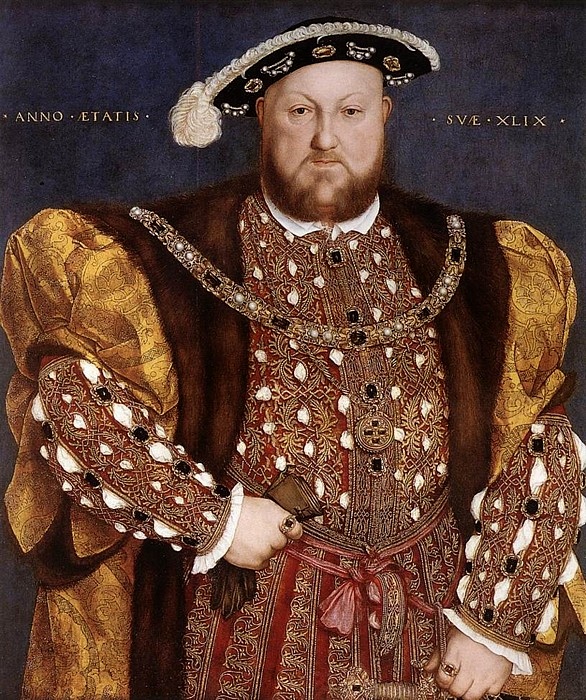
You see here on this page one of the greatest Renaissance portraits of all time. It was painted by Hans Holbein who embodied the international essence of the 16th century Renaissance. In the 16th century, the ideas and the authors and the books moved all over Europe as did its greatest of artists. Holbein was a good example of this. Born in Asbury, Germany, Holbein travelled to England in 1526 in search of work with a recommendation from Erasmus. He was welcomed into the humanist circle of Thomas More, where he quickly built a high reputation. He returned to Basel for four years, then resumed his career in England in 1532 under the patronage of Anne Boleyn and Thomas Cromwell. By 1535, he was King's Painter to Henry VIII of England.
RECOMMENDED READING:

John Hale,
The Civilization of Europe in the Renaissance,
Scribner, Reprint edition (June 1, 1995),
ISBN 0684803526
RECOMMENDED READING:
This is a beautiful book which covers the whole of the Renaissance in every field and every country. Margaret King is one of the greatest American scholars of the Renaissance, and she has written a very useful general book on the subject. What is especially attractive, is all the extra material: the charts, the maps, the photos, all of which make this a great study of the Renaissance. It would be a useful "textbook" for our whole year on the Renaissance. It was, of course, designed as a college textbook for a course on the Renaissance. If you buy a new copy, it is 35$ but there are many used copies listed on Amazon.
Margaret L. King, is Professor Emerita of history at Brooklyn College and the Graduate Center, City University of New York. She is the author of several books on women, humanism, and Venice in the Renaissance, and is currently editor-in-chief of the Renaissance and Reformation online bibliography published by Oxford Bibliographies.

Margaret L. King,
The Renaissance in Europe,
Laurence King Publishing; 2 edition (January 1, 2003),
ISBN 1856693740
29
Week 29: Monday, May 26, 2025
The Renaissance in England: Elizabeth I
Week 29
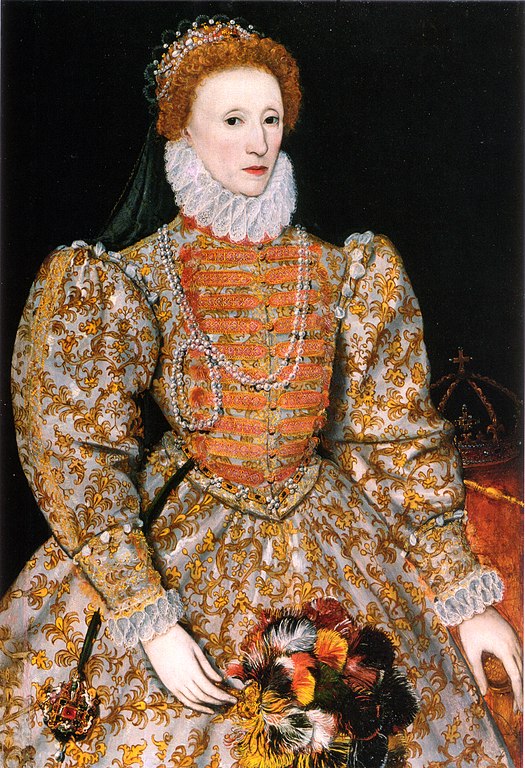 Elizabeth I (7 September 1533 – 24 March 1603) was Queen of England and Ireland from 17 November 1558 until her death in 1603. She was the last monarch of the House of Tudor. Elizabeth was the only surviving child of Henry VIII and his second wife, Anne Boleyn. When Elizabeth was two years old, her parents' marriage was annulled, her mother was executed, and Elizabeth was declared illegitimate. Henry restored her to the line of succession when she was 10, via the Third Succession Act 1543. After Henry's death in 1547, Elizabeth's younger half-brother Edward VI ruled until his own death in 1553, bequeathing the crown to a Protestant cousin, Lady Jane Grey, and ignoring the claims of his two half-sisters, the Catholic Mary and the younger Elizabeth, in spite of statutes to the contrary. Edward's will was set aside within weeks of his death and Mary became queen, deposing and executing Jane. During Mary's reign, Elizabeth was imprisoned for nearly a year on suspicion of supporting Protestant rebels. Upon her half-sister's death in 1558, Elizabeth succeeded to the throne and set out to rule by good counsel. She depended heavily on a group of trusted advisers led by William Cecil, whom she created Baron Burghley. One of her first actions as queen was the establishment of an English Protestant church, of which she became the supreme governor. This era, later named the Elizabethan Religious Settlement, would evolve into the Church of England. It was expected that Elizabeth would marry and produce an heir; however, despite numerous courtships, she never did, and because of this she is sometimes referred to as the "Virgin Queen". She was eventually succeeded by her first cousin twice removed, James VI of Scotland, the son of Mary, Queen of Scots. In government, Elizabeth was more moderate than her father and siblings had been. One of her mottoes was video et taceo ("I see and keep silent"). In religion, she was relatively tolerant and avoided systematic persecution. After the pope declared her illegitimate in 1570, which in theory released English Catholics from allegiance to her, several conspiracies threatened her life, all of which were defeated with the help of her ministers' secret service, run by Sir Francis Walsingham. Elizabeth was cautious in foreign affairs, manoeuvring between the major powers of France and Spain. She half-heartedly supported a number of military campaigns in the Netherlands, France, and Ireland. By the mid-1580s, England could no longer avoid war with Spain. As she grew older, Elizabeth became celebrated for her virginity. A cult of personality grew around her which was celebrated in the portraits, pageants, and literature of the day. Elizabeth's reign became known as the Elizabethan era. The period is famous for the flourishing of English drama, led by playwrights such as William Shakespeare and Christopher Marlowe, the prowess of English maritime adventurers, such as Francis Drake and Walter Raleigh, and for the defeat of the Spanish Armada. Elizabeth is acknowledged as a charismatic performer ("Gloriana") and a dogged survivor ("Good Queen Bess") in an era when government was ramshackle and limited, and when monarchs in neighbouring countries faced internal problems that jeopardised their thrones. After the short, disastrous reigns of her half-siblings, her 44 years on the throne provided welcome stability for the kingdom and helped to forge a sense of national identity.
Elizabeth I (7 September 1533 – 24 March 1603) was Queen of England and Ireland from 17 November 1558 until her death in 1603. She was the last monarch of the House of Tudor. Elizabeth was the only surviving child of Henry VIII and his second wife, Anne Boleyn. When Elizabeth was two years old, her parents' marriage was annulled, her mother was executed, and Elizabeth was declared illegitimate. Henry restored her to the line of succession when she was 10, via the Third Succession Act 1543. After Henry's death in 1547, Elizabeth's younger half-brother Edward VI ruled until his own death in 1553, bequeathing the crown to a Protestant cousin, Lady Jane Grey, and ignoring the claims of his two half-sisters, the Catholic Mary and the younger Elizabeth, in spite of statutes to the contrary. Edward's will was set aside within weeks of his death and Mary became queen, deposing and executing Jane. During Mary's reign, Elizabeth was imprisoned for nearly a year on suspicion of supporting Protestant rebels. Upon her half-sister's death in 1558, Elizabeth succeeded to the throne and set out to rule by good counsel. She depended heavily on a group of trusted advisers led by William Cecil, whom she created Baron Burghley. One of her first actions as queen was the establishment of an English Protestant church, of which she became the supreme governor. This era, later named the Elizabethan Religious Settlement, would evolve into the Church of England. It was expected that Elizabeth would marry and produce an heir; however, despite numerous courtships, she never did, and because of this she is sometimes referred to as the "Virgin Queen". She was eventually succeeded by her first cousin twice removed, James VI of Scotland, the son of Mary, Queen of Scots. In government, Elizabeth was more moderate than her father and siblings had been. One of her mottoes was video et taceo ("I see and keep silent"). In religion, she was relatively tolerant and avoided systematic persecution. After the pope declared her illegitimate in 1570, which in theory released English Catholics from allegiance to her, several conspiracies threatened her life, all of which were defeated with the help of her ministers' secret service, run by Sir Francis Walsingham. Elizabeth was cautious in foreign affairs, manoeuvring between the major powers of France and Spain. She half-heartedly supported a number of military campaigns in the Netherlands, France, and Ireland. By the mid-1580s, England could no longer avoid war with Spain. As she grew older, Elizabeth became celebrated for her virginity. A cult of personality grew around her which was celebrated in the portraits, pageants, and literature of the day. Elizabeth's reign became known as the Elizabethan era. The period is famous for the flourishing of English drama, led by playwrights such as William Shakespeare and Christopher Marlowe, the prowess of English maritime adventurers, such as Francis Drake and Walter Raleigh, and for the defeat of the Spanish Armada. Elizabeth is acknowledged as a charismatic performer ("Gloriana") and a dogged survivor ("Good Queen Bess") in an era when government was ramshackle and limited, and when monarchs in neighbouring countries faced internal problems that jeopardised their thrones. After the short, disastrous reigns of her half-siblings, her 44 years on the throne provided welcome stability for the kingdom and helped to forge a sense of national identity.
(Wikipedia)
RECOMMENDED READING:

John Hale,
The Civilization of Europe in the Renaissance,
Scribner, Reprint edition (June 1, 1995),
ISBN 0684803526
RECOMMENDED READING:
This is a beautiful book which covers the whole of the Renaissance in every field and every country. Margaret King is one of the greatest American scholars of the Renaissance, and she has written a very useful general book on the subject. What is especially attractive, is all the extra material: the charts, the maps, the photos, all of which make this a great study of the Renaissance. It would be a useful "textbook" for our whole year on the Renaissance. It was, of course, designed as a college textbook for a course on the Renaissance. If you buy a new copy, it is 35$ but there are many used copies listed on Amazon.
Margaret L. King, is Professor Emerita of history at Brooklyn College and the Graduate Center, City University of New York. She is the author of several books on women, humanism, and Venice in the Renaissance, and is currently editor-in-chief of the Renaissance and Reformation online bibliography published by Oxford Bibliographies.

Margaret L. King,
The Renaissance in Europe,
Laurence King Publishing; 2 edition (January 1, 2003),
ISBN 1856693740
30
Week 30: Monday, June 2, 2025
The Renaissance Achievement
Week 30
The European Renaissance extends from about 1400 to 1600. Many scholars of various Italian city-states, especially Venice, will argue that the Renaissance continued long after the year 1600 and that is probably correct. So the exact dating of the waning of the Renaissance as a period in European history is wide open to debate. But in many ways the 17th century is a real modern world; the long age of transition is over. And in the 1600s we can see clearly the outline of modern society. For one thing, people start to use the word "modern." So what did the Renaissance achieve in its 200+ years? It changed European civilization forever. It ushered in a new age of knowledge; science; research; publications in print; translations from all languages; international travel to the newly discovered areas of the globe. It carried Western Civilization out of the Middle Ages and into the modern world. It is the great hinge, the cardinal point, in the long story of the West.
RECOMMENDED READING:

John Hale,
The Civilization of Europe in the Renaissance,
Scribner, Reprint edition (June 1, 1995),
ISBN 0684803526
RECOMMENDED READING:
This is a beautiful book which covers the whole of the Renaissance in every field and every country. Margaret King is one of the greatest American scholars of the Renaissance, and she has written a very useful general book on the subject. What is especially attractive, is all the extra material: the charts, the maps, the photos, all of which make this a great study of the Renaissance. It would be a useful "textbook" for our whole year on the Renaissance. It was, of course, designed as a college textbook for a course on the Renaissance. If you buy a new copy, it is 35$ but there are many used copies listed on Amazon.
Margaret L. King, is Professor Emerita of history at Brooklyn College and the Graduate Center, City University of New York. She is the author of several books on women, humanism, and Venice in the Renaissance, and is currently editor-in-chief of the Renaissance and Reformation online bibliography published by Oxford Bibliographies.

Margaret L. King,
The Renaissance in Europe,
Laurence King Publishing; 2 edition (January 1, 2003),
ISBN 1856693740
All
Week 21: Mon., Mar. 31, 2025
Renaissance in France: Francis I & Guillaume Budé
Week 21
The two men pictured here are central to this week's study, since it is during the lifetime of King Francis I, that France engages fully with the ideas and artistic achievements of the Italian Renaissance. Budé was the intellectual teacher for the King on those educational ideas that mattered. His influence would help to change Medieval France into Renaissance France. One such idea was a college that would prepare young French students with a knowledge of Latin and Greek (Hebrew too) and the cultural heritage of Rome and Greece. In other words, Budé's idea about the College of France (which the King founded as recommended by Budé) was the very core of all modern ideas about an education in the humanities before graduate school (Medical, Legal, or Business). From 1500 to 2000 most colleges would have agreed and would have provided, until recently, exactly this humanistic education that Budé recommended.
RECOMMENDED READING:
J. R. Hale, The Civilization of Europe in the Renaissance. This study of the whole Renaissance period in all of Europe was the final masterpiece of one of the greatest historians of the Early Modern period. John Hale was working on this book when he suffered a debilitating stroke. But his wife, Sheila Hale, and other scholars finished the book for publication and we are all enriched by its availability. It is in print, but you might also look at used copies of the original quality paperback. This book will serve us for the whole year-long course. It is especially useful for Winter and Spring Quarters.

John Hale,
The Civilization of Europe in the Renaissance,
Scribner, Reprint edition (June 1, 1995),
ISBN 0684803526
Week 22: Mon., Apr. 7, 2025
The Renaissance in France: Italian Artists in France
Week 22

The chateau above is Chambord. It is the single best example of the power of Italian Renaissance art in France. It is very possibly the idea of Leonardo da Vinci who lived in Amboise as the guest of King Francis I in the last years of his life. That Leonardo would choose France for his last years, tells us of the attraction that the northern kingdom held for Italians. Leonardo was the most celebrated Italian painter of the time. His painting of the Last Supper in Milan, was now the most famous painting anywhere in Europe. Did he plan this fabulous chateau with Francis? If he did, and I think he did, then it remains to this day the best example of the enduring power of Renaissance classicism, the same architectural style that would soon be described in detail in the great book by Andrea Palladio published in Venice in 1570, the single most influential book on architecture ever published.
Week 23: Mon., Apr. 14, 2025
The Renaissance in Spain: Ferdinand and Isabella
Week 23
 The photo above is of the tomb of Juan, Prince of Asturias, the beloved son of Ferdinand and Isabella. The prince, the future ruler of the united nation of Spain, had died in 1497. And here in this monastery, Domenico Fancelli from Florence, carved this magnificent tomb using all the knowledge and skill that had been accumulated in Renaissance Florence. Later he also created the great tombs for Ferdinand and Isabella in Granada.
The photo above is of the tomb of Juan, Prince of Asturias, the beloved son of Ferdinand and Isabella. The prince, the future ruler of the united nation of Spain, had died in 1497. And here in this monastery, Domenico Fancelli from Florence, carved this magnificent tomb using all the knowledge and skill that had been accumulated in Renaissance Florence. Later he also created the great tombs for Ferdinand and Isabella in Granada.
RECOMMENDED READING:
J. R. Hale, The Civilization of Europe in the Renaissance. This study of the whole Renaissance period in all of Europe was the final masterpiece of one of the greatest historians of the Early Modern period. John Hale was working on this book when he suffered a debilitating stroke. But his wife, Sheila Hale, and other scholars finished the book for publication and we are all enriched by its availability. It is in print, but you might also look at used copies of the original quality paperback. This book will serve us for the whole year-long course. It is especially useful for Winter and Spring Quarters.

John Hale,
The Civilization of Europe in the Renaissance,
Scribner, Reprint edition (June 1, 1995),
ISBN 0684803526
RECOMMENDED READING:
This is a beautiful book which covers the whole of the Renaissance in every field and every country. Margaret King is one of the greatest American scholars of the Renaissance, and she has written a very useful general book on the subject. What is especially attractive, is all the extra material: the charts, the maps, the photos, all of which make this a great study of the Renaissance. It would be a useful "textbook" for our whole year on the Renaissance. It was, of course, designed as a college textbook for a course on the Renaissance. If you buy a new copy, it is 35$ but there are many used copies listed on Amazon.
Margaret L. King, is Professor Emerita of history at Brooklyn College and the Graduate Center, City University of New York. She is the author of several books on women, humanism, and Venice in the Renaissance, and is currently editor-in-chief of the Renaissance and Reformation online bibliography published by Oxford Bibliographies.

Margaret L. King,
The Renaissance in Europe,
Laurence King Publishing; 2 edition (January 1, 2003),
ISBN 1856693740
Week 24: Mon., Apr. 21, 2025
The Renaissance in Spain: Women
Week 24
In the Fifteenth and Sixteenth Century, the definition of a good life for a woman changed. The Renaissance produced a whole new idea about what was the right role for a woman. Spain produced one of the most remarkable women of the age: Queen Isabella of Castile. Isabella was an extraordinary woman ruler. She brought the warring factions of Castile together and with the help of her husband Ferdinand from Aragon, she united all of Spain. But her achievement was only more extraordinary when you realize that her daughters learned what their mother taught them and they too went on to important roles in various European courts.
RECOMMENDED READING:
J. R. Hale, The Civilization of Europe in the Renaissance. This study of the whole Renaissance period in all of Europe was the final masterpiece of one of the greatest historians of the Early Modern period. John Hale was working on this book when he suffered a debilitating stroke. But his wife, Sheila Hale, and other scholars finished the book for publication and we are all enriched by its availability. It is in print, but you might also look at used copies of the original quality paperback. This book will serve us for the whole year-long course. It is especially useful for Winter and Spring Quarters.

John Hale,
The Civilization of Europe in the Renaissance,
Scribner, Reprint edition (June 1, 1995),
ISBN 0684803526
RECOMMENDED READING:
This is a beautiful book which covers the whole of the Renaissance in every field and every country. Margaret King is one of the greatest American scholars of the Renaissance, and she has written a very useful general book on the subject. What is especially attractive, is all the extra material: the charts, the maps, the photos, all of which make this a great study of the Renaissance. It would be a useful "textbook" for our whole year on the Renaissance. It was, of course, designed as a college textbook for a course on the Renaissance. If you buy a new copy, it is 35$ but there are many used copies listed on Amazon.
Margaret L. King, is Professor Emerita of history at Brooklyn College and the Graduate Center, City University of New York. She is the author of several books on women, humanism, and Venice in the Renaissance, and is currently editor-in-chief of the Renaissance and Reformation online bibliography published by Oxford Bibliographies.

Margaret L. King,
The Renaissance in Europe,
Laurence King Publishing; 2 edition (January 1, 2003),
ISBN 1856693740
Week 25: Mon., Apr. 28, 2025
Renaissance Man: Emperor Charles V
Week 25

The portrait of Charles V that you see at the left was painted by Titian and is currently on view in the Prado in Madrid. Charles V (and also at the same time King Carlos I of Spain) was the single most important, the most powerful, the most dominant personality of the sixteenth century in Europe. Charles lived from 1500 to 1558 and thus he dominated the whole first half of the century and his influence continued through the rest of the century through the person of his son King Philip II who was his student in the intricacies of 16th century government and followed his policies loyally. Charles's biography is the story of someone who grew up in many states and using many languages, but who in the last years of his life became more and more Spanish. He became the most elegant, the most powerful and the best educated Renaissance Man of the century.
RECOMMENDED READING:

John Hale,
The Civilization of Europe in the Renaissance,
Scribner, Reprint edition (June 1, 1995),
ISBN 0684803526
RECOMMENDED READING:
This is a beautiful book which covers the whole of the Renaissance in every field and every country. Margaret King is one of the greatest American scholars of the Renaissance, and she has written a very useful general book on the subject. What is especially attractive, is all the extra material: the charts, the maps, the photos, all of which make this a great study of the Renaissance. It would be a useful "textbook" for our whole year on the Renaissance. It was, of course, designed as a college textbook for a course on the Renaissance. If you buy a new copy, it is 35$ but there are many used copies listed on Amazon.
Margaret L. King, is Professor Emerita of history at Brooklyn College and the Graduate Center, City University of New York. She is the author of several books on women, humanism, and Venice in the Renaissance, and is currently editor-in-chief of the Renaissance and Reformation online bibliography published by Oxford Bibliographies.

Margaret L. King,
The Renaissance in Europe,
Laurence King Publishing; 2 edition (January 1, 2003),
ISBN 1856693740
Week 26: Mon., May. 5, 2025
The Renaissance in Germany: Martin Luther
Week 26
The portrait of Martin Luther on this page was painted by Lucas Cranach in 1528, when Luther was becoming the most famous writer in Europe. We now think of Luther as a Reformation leader. But Luther was a Renaissance scholar before he became a Reformation leader. Like all the men in the Reformation movement, Luther was a great Classical scholar who knew Latin and Greek. He was a scholar, a university professor, before he was anything else. And his career before 1517, shows us that the Reformation was nourished by Renaissance scholarship before the religious fireworks exploded. The Renaissance led to the Reformation.
RECOMMENDED READING:

John Hale,
The Civilization of Europe in the Renaissance,
Scribner, Reprint edition (June 1, 1995),
ISBN 0684803526
RECOMMENDED READING:
This is a beautiful book which covers the whole of the Renaissance in every field and every country. Margaret King is one of the greatest American scholars of the Renaissance, and she has written a very useful general book on the subject. What is especially attractive, is all the extra material: the charts, the maps, the photos, all of which make this a great study of the Renaissance. It would be a useful "textbook" for our whole year on the Renaissance. It was, of course, designed as a college textbook for a course on the Renaissance. If you buy a new copy, it is 35$ but there are many used copies listed on Amazon.
Margaret L. King, is Professor Emerita of history at Brooklyn College and the Graduate Center, City University of New York. She is the author of several books on women, humanism, and Venice in the Renaissance, and is currently editor-in-chief of the Renaissance and Reformation online bibliography published by Oxford Bibliographies.

Margaret L. King,
The Renaissance in Europe,
Laurence King Publishing; 2 edition (January 1, 2003),
ISBN 1856693740
Week 27: Mon., May. 12, 2025
The Renaissance in the Netherlands: Erasmus
Week 27
Above you see the brilliant portrait of Erasmus by his friend Hans Holbein. Erasmus was famous much before Luther. And his achievement of publishing and New Testament in Latin and Greek provided Luther with much of the work for his own German Bible. Erasmus and Luther shared much in their mutual disdain for the corruption of the Roman church. But Erasmus stopped short of breaking completely with Rome. Thus, Luther and Erasmus show us two possible roads in the early 16th century: one led to total rebellion and the other one led to the reformed Roman church.
RECOMMENDED READING:

John Hale,
The Civilization of Europe in the Renaissance,
Scribner, Reprint edition (June 1, 1995),
ISBN 0684803526
RECOMMENDED READING:
This is a beautiful book which covers the whole of the Renaissance in every field and every country. Margaret King is one of the greatest American scholars of the Renaissance, and she has written a very useful general book on the subject. What is especially attractive, is all the extra material: the charts, the maps, the photos, all of which make this a great study of the Renaissance. It would be a useful "textbook" for our whole year on the Renaissance. It was, of course, designed as a college textbook for a course on the Renaissance. If you buy a new copy, it is 35$ but there are many used copies listed on Amazon.
Margaret L. King, is Professor Emerita of history at Brooklyn College and the Graduate Center, City University of New York. She is the author of several books on women, humanism, and Venice in the Renaissance, and is currently editor-in-chief of the Renaissance and Reformation online bibliography published by Oxford Bibliographies.

Margaret L. King,
The Renaissance in Europe,
Laurence King Publishing; 2 edition (January 1, 2003),
ISBN 1856693740

Desiderius Erasmus,
The Praise of Folly and Other Writings,
Robert M. Adams, editor,
W. W. Norton & Company; 1st ed edition (October 17, 1989),
ISBN 0393957497
Week 28: Mon., May. 19, 2025
The Renaissance in England: Henry VIII
Week 29

You see here on this page one of the greatest Renaissance portraits of all time. It was painted by Hans Holbein who embodied the international essence of the 16th century Renaissance. In the 16th century, the ideas and the authors and the books moved all over Europe as did its greatest of artists. Holbein was a good example of this. Born in Asbury, Germany, Holbein travelled to England in 1526 in search of work with a recommendation from Erasmus. He was welcomed into the humanist circle of Thomas More, where he quickly built a high reputation. He returned to Basel for four years, then resumed his career in England in 1532 under the patronage of Anne Boleyn and Thomas Cromwell. By 1535, he was King's Painter to Henry VIII of England.
RECOMMENDED READING:

John Hale,
The Civilization of Europe in the Renaissance,
Scribner, Reprint edition (June 1, 1995),
ISBN 0684803526
RECOMMENDED READING:
This is a beautiful book which covers the whole of the Renaissance in every field and every country. Margaret King is one of the greatest American scholars of the Renaissance, and she has written a very useful general book on the subject. What is especially attractive, is all the extra material: the charts, the maps, the photos, all of which make this a great study of the Renaissance. It would be a useful "textbook" for our whole year on the Renaissance. It was, of course, designed as a college textbook for a course on the Renaissance. If you buy a new copy, it is 35$ but there are many used copies listed on Amazon.
Margaret L. King, is Professor Emerita of history at Brooklyn College and the Graduate Center, City University of New York. She is the author of several books on women, humanism, and Venice in the Renaissance, and is currently editor-in-chief of the Renaissance and Reformation online bibliography published by Oxford Bibliographies.

Margaret L. King,
The Renaissance in Europe,
Laurence King Publishing; 2 edition (January 1, 2003),
ISBN 1856693740
Week 29: Mon., May. 26, 2025
The Renaissance in England: Elizabeth I
Week 29
 Elizabeth I (7 September 1533 – 24 March 1603) was Queen of England and Ireland from 17 November 1558 until her death in 1603. She was the last monarch of the House of Tudor. Elizabeth was the only surviving child of Henry VIII and his second wife, Anne Boleyn. When Elizabeth was two years old, her parents' marriage was annulled, her mother was executed, and Elizabeth was declared illegitimate. Henry restored her to the line of succession when she was 10, via the Third Succession Act 1543. After Henry's death in 1547, Elizabeth's younger half-brother Edward VI ruled until his own death in 1553, bequeathing the crown to a Protestant cousin, Lady Jane Grey, and ignoring the claims of his two half-sisters, the Catholic Mary and the younger Elizabeth, in spite of statutes to the contrary. Edward's will was set aside within weeks of his death and Mary became queen, deposing and executing Jane. During Mary's reign, Elizabeth was imprisoned for nearly a year on suspicion of supporting Protestant rebels. Upon her half-sister's death in 1558, Elizabeth succeeded to the throne and set out to rule by good counsel. She depended heavily on a group of trusted advisers led by William Cecil, whom she created Baron Burghley. One of her first actions as queen was the establishment of an English Protestant church, of which she became the supreme governor. This era, later named the Elizabethan Religious Settlement, would evolve into the Church of England. It was expected that Elizabeth would marry and produce an heir; however, despite numerous courtships, she never did, and because of this she is sometimes referred to as the "Virgin Queen". She was eventually succeeded by her first cousin twice removed, James VI of Scotland, the son of Mary, Queen of Scots. In government, Elizabeth was more moderate than her father and siblings had been. One of her mottoes was video et taceo ("I see and keep silent"). In religion, she was relatively tolerant and avoided systematic persecution. After the pope declared her illegitimate in 1570, which in theory released English Catholics from allegiance to her, several conspiracies threatened her life, all of which were defeated with the help of her ministers' secret service, run by Sir Francis Walsingham. Elizabeth was cautious in foreign affairs, manoeuvring between the major powers of France and Spain. She half-heartedly supported a number of military campaigns in the Netherlands, France, and Ireland. By the mid-1580s, England could no longer avoid war with Spain. As she grew older, Elizabeth became celebrated for her virginity. A cult of personality grew around her which was celebrated in the portraits, pageants, and literature of the day. Elizabeth's reign became known as the Elizabethan era. The period is famous for the flourishing of English drama, led by playwrights such as William Shakespeare and Christopher Marlowe, the prowess of English maritime adventurers, such as Francis Drake and Walter Raleigh, and for the defeat of the Spanish Armada. Elizabeth is acknowledged as a charismatic performer ("Gloriana") and a dogged survivor ("Good Queen Bess") in an era when government was ramshackle and limited, and when monarchs in neighbouring countries faced internal problems that jeopardised their thrones. After the short, disastrous reigns of her half-siblings, her 44 years on the throne provided welcome stability for the kingdom and helped to forge a sense of national identity.
Elizabeth I (7 September 1533 – 24 March 1603) was Queen of England and Ireland from 17 November 1558 until her death in 1603. She was the last monarch of the House of Tudor. Elizabeth was the only surviving child of Henry VIII and his second wife, Anne Boleyn. When Elizabeth was two years old, her parents' marriage was annulled, her mother was executed, and Elizabeth was declared illegitimate. Henry restored her to the line of succession when she was 10, via the Third Succession Act 1543. After Henry's death in 1547, Elizabeth's younger half-brother Edward VI ruled until his own death in 1553, bequeathing the crown to a Protestant cousin, Lady Jane Grey, and ignoring the claims of his two half-sisters, the Catholic Mary and the younger Elizabeth, in spite of statutes to the contrary. Edward's will was set aside within weeks of his death and Mary became queen, deposing and executing Jane. During Mary's reign, Elizabeth was imprisoned for nearly a year on suspicion of supporting Protestant rebels. Upon her half-sister's death in 1558, Elizabeth succeeded to the throne and set out to rule by good counsel. She depended heavily on a group of trusted advisers led by William Cecil, whom she created Baron Burghley. One of her first actions as queen was the establishment of an English Protestant church, of which she became the supreme governor. This era, later named the Elizabethan Religious Settlement, would evolve into the Church of England. It was expected that Elizabeth would marry and produce an heir; however, despite numerous courtships, she never did, and because of this she is sometimes referred to as the "Virgin Queen". She was eventually succeeded by her first cousin twice removed, James VI of Scotland, the son of Mary, Queen of Scots. In government, Elizabeth was more moderate than her father and siblings had been. One of her mottoes was video et taceo ("I see and keep silent"). In religion, she was relatively tolerant and avoided systematic persecution. After the pope declared her illegitimate in 1570, which in theory released English Catholics from allegiance to her, several conspiracies threatened her life, all of which were defeated with the help of her ministers' secret service, run by Sir Francis Walsingham. Elizabeth was cautious in foreign affairs, manoeuvring between the major powers of France and Spain. She half-heartedly supported a number of military campaigns in the Netherlands, France, and Ireland. By the mid-1580s, England could no longer avoid war with Spain. As she grew older, Elizabeth became celebrated for her virginity. A cult of personality grew around her which was celebrated in the portraits, pageants, and literature of the day. Elizabeth's reign became known as the Elizabethan era. The period is famous for the flourishing of English drama, led by playwrights such as William Shakespeare and Christopher Marlowe, the prowess of English maritime adventurers, such as Francis Drake and Walter Raleigh, and for the defeat of the Spanish Armada. Elizabeth is acknowledged as a charismatic performer ("Gloriana") and a dogged survivor ("Good Queen Bess") in an era when government was ramshackle and limited, and when monarchs in neighbouring countries faced internal problems that jeopardised their thrones. After the short, disastrous reigns of her half-siblings, her 44 years on the throne provided welcome stability for the kingdom and helped to forge a sense of national identity.
(Wikipedia)
RECOMMENDED READING:

John Hale,
The Civilization of Europe in the Renaissance,
Scribner, Reprint edition (June 1, 1995),
ISBN 0684803526
RECOMMENDED READING:
This is a beautiful book which covers the whole of the Renaissance in every field and every country. Margaret King is one of the greatest American scholars of the Renaissance, and she has written a very useful general book on the subject. What is especially attractive, is all the extra material: the charts, the maps, the photos, all of which make this a great study of the Renaissance. It would be a useful "textbook" for our whole year on the Renaissance. It was, of course, designed as a college textbook for a course on the Renaissance. If you buy a new copy, it is 35$ but there are many used copies listed on Amazon.
Margaret L. King, is Professor Emerita of history at Brooklyn College and the Graduate Center, City University of New York. She is the author of several books on women, humanism, and Venice in the Renaissance, and is currently editor-in-chief of the Renaissance and Reformation online bibliography published by Oxford Bibliographies.

Margaret L. King,
The Renaissance in Europe,
Laurence King Publishing; 2 edition (January 1, 2003),
ISBN 1856693740
Week 30: Mon., Jun. 2, 2025
The Renaissance Achievement
Week 30
The European Renaissance extends from about 1400 to 1600. Many scholars of various Italian city-states, especially Venice, will argue that the Renaissance continued long after the year 1600 and that is probably correct. So the exact dating of the waning of the Renaissance as a period in European history is wide open to debate. But in many ways the 17th century is a real modern world; the long age of transition is over. And in the 1600s we can see clearly the outline of modern society. For one thing, people start to use the word "modern." So what did the Renaissance achieve in its 200+ years? It changed European civilization forever. It ushered in a new age of knowledge; science; research; publications in print; translations from all languages; international travel to the newly discovered areas of the globe. It carried Western Civilization out of the Middle Ages and into the modern world. It is the great hinge, the cardinal point, in the long story of the West.
RECOMMENDED READING:

John Hale,
The Civilization of Europe in the Renaissance,
Scribner, Reprint edition (June 1, 1995),
ISBN 0684803526
RECOMMENDED READING:
This is a beautiful book which covers the whole of the Renaissance in every field and every country. Margaret King is one of the greatest American scholars of the Renaissance, and she has written a very useful general book on the subject. What is especially attractive, is all the extra material: the charts, the maps, the photos, all of which make this a great study of the Renaissance. It would be a useful "textbook" for our whole year on the Renaissance. It was, of course, designed as a college textbook for a course on the Renaissance. If you buy a new copy, it is 35$ but there are many used copies listed on Amazon.
Margaret L. King, is Professor Emerita of history at Brooklyn College and the Graduate Center, City University of New York. She is the author of several books on women, humanism, and Venice in the Renaissance, and is currently editor-in-chief of the Renaissance and Reformation online bibliography published by Oxford Bibliographies.

Margaret L. King,
The Renaissance in Europe,
Laurence King Publishing; 2 edition (January 1, 2003),
ISBN 1856693740
